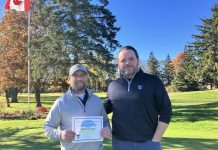
When a driver spotted a red-tailed hawk sitting in the same spot near Havelock hours after seeing him the first time, he knew something was not right.
After being taken to the Woodlands Wildlife Sanctuary in Minden, the bird of prey (who was named Slater) was found to be bloodied, underweight, and suffering from rodenticide toxicity — poison that can affect not just targeted rodents but also birds of prey, wildlife, pets, and even humans.
“We’re in a biodiversity crisis here and we need to really take this seriously,” says Allison Hansen, co-founder and campaign director at Rodenticide Free Ontario (RFO), a citizen-led organization dedicated to protecting wildlife, pets, and people from the risks of rodenticides.
A resident of Minden Hills and a long-time animal advocate, Hansen founded the campaign in 2021 after her sister’s dog was poisoned by rodenticides. Shortly after, her own dog died from secondary exposure caused by the consumption of a poisoned animal.
“When she got sick, I started to do as much research as possible and found how horribly ineffective, dangerous, and inhumane these products are,” says Hansen.
To launch RFO, Hansen gained support from the Defend Them All Foundation which helped champion the moratorium on getting certain products banned in British Columbia. RFO advocates for a province-wide ban on rodenticides by working with municipalities such as Pickering, which became the province’s first to pass a policy limiting the use of “rat poison” on city property.
“The issue with these poisons, in particular the anticoagulants, is that they don’t kill the intended target immediately, so it takes several days for them to die,” says Hansen. “In that time frame, they are observed going back and forth to feed on this poison multiple times, spending more time out in the open and dying slow and painful deaths, which makes them easier (for animals such as wildlife and pets) to prey upon (them).”
PDF: Rodenticide Free Ontario Fact Sheet
Rodenticide Free Ontario Fact Sheet
Hansen explains that these ingested poisons can remain in the liver for upwards of a year. While a predator might not get a lethal dose from feeding on one poisoned rat, upon continuing to consume several, their immune system will continue to be suppressed, making the animal more susceptible to mange.
“Rehab centres are seeing a lot of cases of extreme mange coming in and it’s affecting reproductive success, hunting success, and then also making them more susceptible to vehicle strikes and window strikes,” she adds. “Part of the issue is (rodenticides) don’t address the root cause of an infestation. By simply placing poisons in and around your home, you’re still not sealing entryways or removing attractants.”
Through RFO, Hansen hears stories from people around Ontario who have had their dogs get into poisons, whether by ingesting it themselves or by secondary exposure from rats and other rodents. Rodenticides can also pose a danger to children.
“They’re brightly coloured and they’re also flavoured to make them attractive, so children can often mistake them for a toy or candy,” Hansen says. “Even though the bait boxes are supposed to be tamper proof, they’re not.”
Monika Melichar, founder and president of Woodlands Wildlife Sanctuary, estimates that rodenticide poisoning affects around 10 per cent of the birds of prey that are admitted into the Minden sanctuary.
Though not often the case, Slater was quickly diagnosed with rodenticide poisoning as he was found to not only be largely underweight, but also to have blood in his mouth, in his stool, and under his skin. Currently, he is housed in an oxygen chamber to assist with his breathing and, to help reverse the damage of the anticoagulants, he is getting daily vitamin K infusions which could last anywhere from two weeks to up to a month.
“That’s really the only protocol that we know is effective,” says Melichar. “It’s a longer-term treatment because this isn’t just an instant cure, but we hope to flush out the toxins.”

“It’s a long shot because this stuff has been accumulating in him for a while, as he would have gotten into this via eating rodents,” adds Hansen.
That, says Melichar, is the greatest concern. While Slater has shown progress in the past few days of treatment, it’s unclear whether more damage has been done to his liver or other organs from the long-term exposure. She adds that it doesn’t help that migratory time is approaching for red-tailed hawks.
“Mid-October to early November is usually the peak time to migrate so he is on the cusp,” she says. “If we can pull him through and get him out of here by mid-November, we would be very happy.”
Melichar predicts that caring for patients with rodenticide costs the sanctuary close to $1,000 per week, including the medication and critical care diets needed for poisoned animals.
The good news is that, on Saturday (October 19), Slater managed to eat solid food on his own for this first time and continues to show signs of gaining strength.
“He is still considered critical, but we’re staying positive that we will be able to save him,” Melichar says. “He is definitely improving, so that’s a good sign.”
To support Slater’s care, donations can be made to the Woodlands Wildlife Sanctuary at www.woodlandswildlifesanctuary.ca/donate. For more information on alternatives to using rodenticides, follow RFO on Facebook.


























